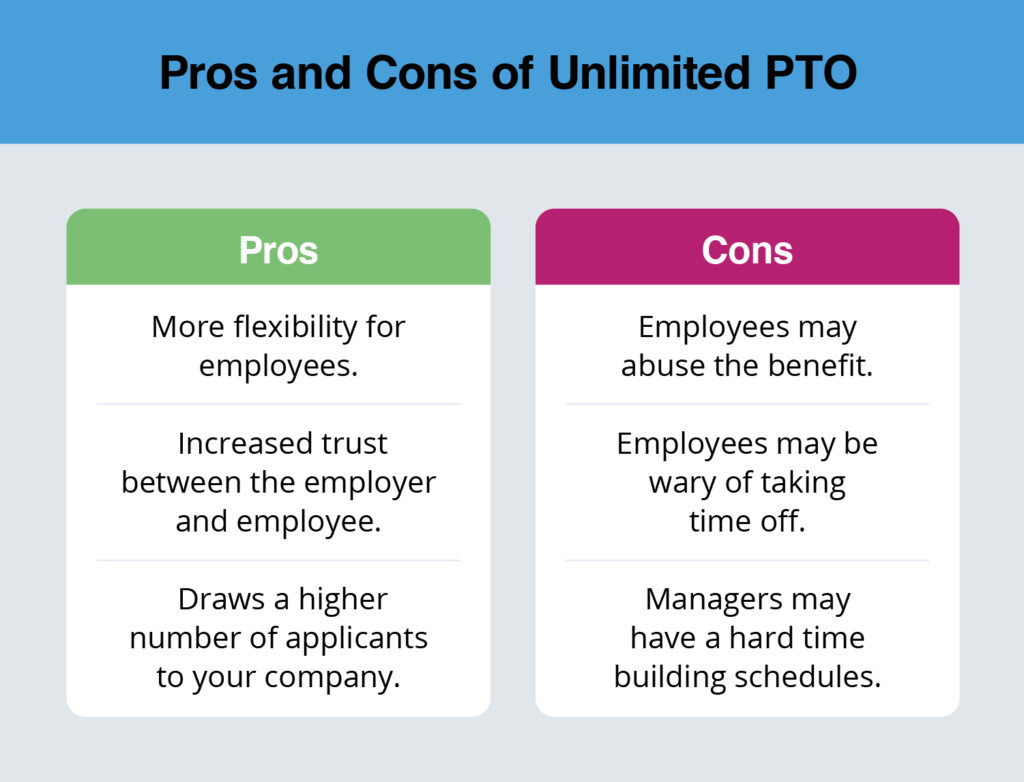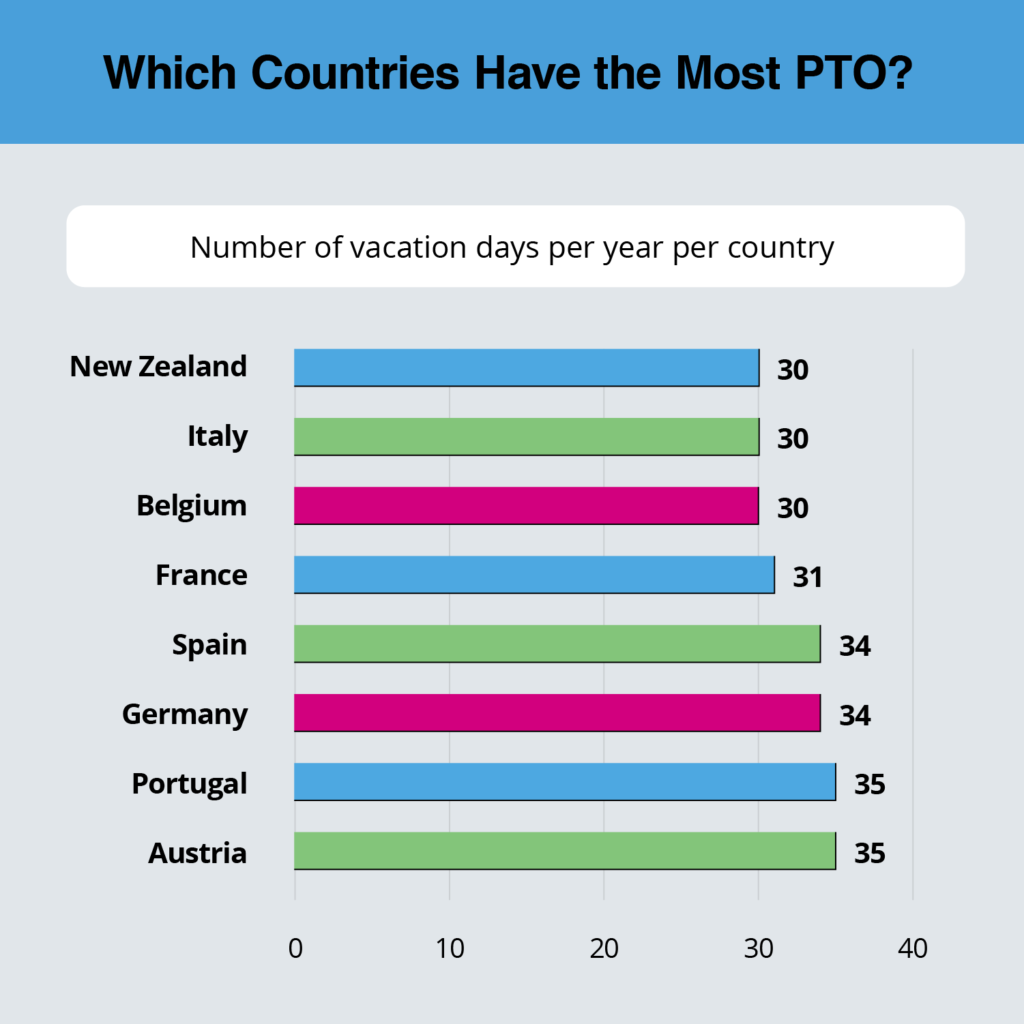Unlimited paid time off (PTO) is a popular benefit for many global companies. The flexibility and generosity of employers trusting their rosters to take as much time off as they need attracts good applicants.
But with attitudes toward vacation (and labor laws) varying from country to country, the logistics of managing an unlimited PTO policy are confusing.
Since we help businesses stay compliant across the globe, we’ve put together a guide to managing an unlimited PTO policy for your dispersed team.
How does unlimited PTO work?
Unlimited PTO means there isn’t a cap on the amount of paid time off an employee can take. This means that PTO doesn’t accrue as employees work, and employees aren’t given a lump sum at the beginning of the year to use as needed.
Instead, employees are free to take time off when they want without worrying about counting days.
In this case, PTO usually encompasses every type of day an employee needs off, including vacation, illness, or mental health days. For many companies, the unlimited PTO benefit doesn’t kick in until the employee has been with the company for at least 90 days.
Some companies still track an employee’s PTO through an online portal, even though it’s unlimited. Others simply allow the employee to block off their calendar when they’ll be out of office and receive approval from their manager. In those cases, PTO usually isn’t tracked.

Pros of unlimited PTO
The biggest pro regarding an unlimited PTO policy is the flexibility it provides. Many employees are excited about the ability to take vacations and still have unlimited PTO in the case a prolonged emergency, illness, or if another need arises.
A few benefits of unlimited PTO include:
- Employees won’t report to work sick
- Managers build trust with their roster
- It draws applicants to your company
- It improves employee retention
Cons of unlimited PTO
Unlimited PTO may make some employees feel scorned. While some on your roster might be comfortable taking as much time off as they can, others may be more conservative with their PTO use, which could lead to disagreements on your team.
A few cons of unlimited PTO include:
- Employees may be wary of using this benefit
- Employees may take too much time off
- Managers may find it difficult to build schedules
In lieu of unlimited PTO, employers may offer a number of floating holidays as part of their limited PTO policy. Floating holidays are paid days off that employees can use at any time and at their discretion.

Global views on PTO
Views on vacation time differ throughout the globe. For example, Americans are usually uncomfortable taking long periods of time off. Workers in Scandinavian or other European countries, on the other hand, are more comfortable taking longer vacations. Australia’s ethos of life experience before work also means many Australian workers take extended leave.
Many countries have a minimum required number of days that employees have to take off per year, which means employees are more comfortable with (and expect) their vacations.
The U.S. is the only global advanced economy that doesn’t require employers to offer any paid time off—although qualified U.S. employees are entitled to unpaid time off.
Unlimited PTO considerations for global teams
It takes careful planning to expand globally. That’s where an employer of record (EOR) can step in to help. An EOR—like Velocity Global—helps you compliantly hire and manage your global workforce.
Compliance
Some countries have a required minimum days off that employees must take. You’ll need to be diligent about how much time off employees living in those countries take to guarantee you are compliant with labor laws in their country. If you don’t, you’ll be fined.
Just a few countries with minimum PTO per year include:
- Finland: 30 days
- Norway: 25 days, or 30 if the employee is over 60 years old
- Peru: 30 days
- Armenia: 20 days, or 25 if the employee’s work includes emotional or intellectual strain
So, if you employed someone in Finland, you’d need to make sure they’re taking at least 30 days off if you want to stay compliant—even if you don’t formally track your employee’s PTO.
Camaraderie
Conflicting global views on paid time off may breed resentment in your global team. For example, a European employee who is used to more relaxed views on work and vacation time will probably feel more comfortable taking multiple extended holidays than an American employee who isn’t used to that perspective.
In cases like these, you must stress that each employee can take full advantage of their unlimited paid time off benefit.
5 tips for managing your global PTO policy
Managing PTO for a global team requires communication and planning.
1. Communicate often
Communication will help keep your global team stay organized and efficient with PTO. Ensure your team knows they can take as much PTO as they want (and they are encouraged to do so), by reminding them of this benefit often.
Also, make sure to check in with team members who leave for or return from PTO to gauge their needs and workload.
2. Have a coverage plan
When someone is about to leave for PTO, prepare a comprehensive and fair coverage plan. No one is going to want to take time off if they come back to large piles of unfinished work. Simultaneously, team members that are consistently given others’ work while they’re on vacation may start to feel aggravated.
Make sure your coverage plan is fairly spread among team members and you thoroughly communicate it before the leaving employee signs off for their vacation.
3. Create a schedule
You don’t want to have multiple team members on vacation at once—especially if they are senior employees or managers. An unlimited PTO policy doesn’t necessarily mean people need to be given the exact dates they want, especially not if it means there will be many team members out at once. Create a schedule to keep track of who will be out of office and when.
4. Don’t overpromise
Don’t say you’re going to offer unlimited PTO if you don’t mean it. If you’re going to cap an employee’s days off once they reach a certain number (even if that number is bigger than some companies), don’t say your PTO is unlimited. This is especially true if you hire employees in countries that expect an extended leave.
5. Check in
Getting feedback from your employees helps identify and fix any pain points in your policies. Ask your employees how they feel about PTO and if they feel comfortable using their unlimited vacation benefits. If they don’t, identify why and what you can do to encourage vacation and how you can make it easy for employees to take it.
Stay compliant with PTO policies
Unlimited PTO is a great benefit that requires care and planning. Staying compliant with global labor laws is not only preferred — it’s a necessity. An EOR helps you hire, manage, and pay your global workforce while still empowering them to take vacation time and work with flexibility.
Contact us to see how our EOR platform can help your global business.



